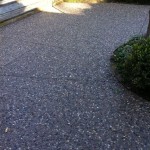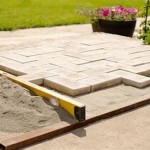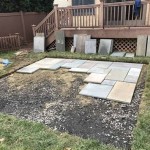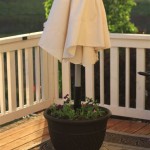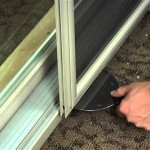Menards Patio Stones: A Comprehensive Guide to Selection, Installation, and Maintenance
Menards offers a wide variety of patio stones, providing homeowners with numerous options for creating beautiful and functional outdoor living spaces. From traditional concrete pavers to natural stone and permeable pavers, the selection caters to diverse aesthetic preferences and project requirements. This article will explore the different types of patio stones available at Menards, discuss key considerations for selection based on project needs, outline the installation process, and provide essential maintenance tips to ensure long-lasting beauty and durability.
Understanding the Types of Patio Stones Available at Menards
Menards categorizes its patio stones based on material, shape, size, color, and texture. The primary materials include concrete, natural stone, and specialized pavers designed for specific applications, such as permeable pavements.
Concrete pavers are a popular choice due to their affordability, durability, and versatility. They are manufactured in a variety of shapes, including rectangular, square, hexagonal, and interlocking designs. Concrete pavers can be dyed in a wide range of colors and textured to mimic the look of natural stone, brick, or other materials. This allows for flexible design options to complement various architectural styles and landscaping themes.
Natural stone pavers offer a unique, organic aesthetic. Options include flagstone, slate, limestone, and granite. Each type of natural stone has its own distinct characteristics in terms of color, texture, and durability. Flagstone, for instance, is characterized by its irregular shapes and natural clefting, creating a rustic and informal look. Slate is known for its smooth, layered surface and subtle color variations. Limestone provides a more uniform appearance with a porous texture. Granite is exceptionally durable and resistant to staining, making it a good choice for high-traffic areas.
Permeable pavers are designed to allow rainwater to pass through the surface and into the ground, reducing stormwater runoff and replenishing groundwater. These pavers typically have wider joints filled with gravel or specialized aggregates that facilitate water infiltration. Permeable pavers are an environmentally friendly option for patios, driveways, and walkways.
Beyond the core materials, Menards also offers specialized pavers for specific applications. These may include edging pavers for creating borders, wall blocks for constructing retaining walls or raised patios, and step stones for creating pathways.
Key Considerations for Selecting Patio Stones
Choosing the right patio stones requires careful consideration of several factors, including intended use, budget, aesthetic preferences, site conditions, and maintenance requirements.
The intended use of the patio will influence the type and thickness of pavers required. For high-traffic areas, such as walkways or driveways, thicker pavers with higher compressive strength are necessary to withstand the weight of vehicles and foot traffic. For patios used primarily for seating and entertaining, thinner pavers may be sufficient.
Budget is a significant consideration. Concrete pavers are generally more affordable than natural stone. Within each material category, prices can vary depending on the size, shape, color, and texture of the pavers. It is important to establish a budget before starting the selection process to narrow down the options and avoid overspending.
Aesthetic preferences play a crucial role in the selection process. Consider the overall style of the home and landscaping when choosing patio stones. Select pavers that complement the architectural style and color scheme of the surrounding environment. Pay attention to the texture and color variations of the pavers to create the desired visual effect. For example, a modern home may benefit from smooth, uniform concrete pavers, while a rustic home may be better suited to irregular flagstone pavers.
Site conditions, such as soil type and drainage, can impact the performance of patio stones. If the soil is poorly drained, it may be necessary to install a drainage system beneath the patio to prevent water from pooling and damaging the pavers. Consider the slope of the site and choose pavers that are appropriate for the grade. In areas with freeze-thaw cycles, select pavers that are resistant to cracking and spalling.
Maintenance requirements should also be considered. Some types of patio stones, such as natural stone, may require more frequent sealing and cleaning than others. Concrete pavers may be susceptible to staining and fading over time. Choose pavers that are relatively easy to clean and maintain to minimize upkeep efforts.
Installation Process: A Step-by-Step Guide
Proper installation is crucial for ensuring the longevity and stability of a patio. The installation process typically involves site preparation, base construction, paver placement, and joint filling.
Site preparation begins with clearing the area of vegetation, debris, and topsoil. Excavate the area to the desired depth, taking into account the thickness of the pavers, base material, and any underlying drainage layers. Ensure that the excavated area is level and compacted.
Base construction involves creating a stable foundation for the pavers. A typical base consists of a layer of compacted gravel topped with a layer of sand. The gravel layer provides drainage and support, while the sand layer provides a level surface for the pavers to rest on. The thickness of the base will depend on the soil conditions and the intended use of the patio. For high-traffic areas, a thicker base is recommended.
Paver placement is the most visible step in the installation process. Start by laying out the pavers in the desired pattern, leaving consistent gaps between each paver. Use a rubber mallet to gently tap the pavers into place, ensuring that they are level and flush with each other. Periodically check the level of the pavers and adjust as needed. Cut pavers to fit around edges and obstacles using a paver saw or chisel.
Joint filling involves filling the gaps between the pavers with sand or polymeric sand. Sand provides a natural look and allows for flexibility, while polymeric sand hardens over time, creating a more stable and weed-resistant surface. Sweep the sand or polymeric sand into the joints, making sure to fill them completely. Compact the sand or polymeric sand with a plate compactor or hand tamper. Water the patio to help the sand or polymeric sand settle into the joints.
Essential Maintenance Tips for Long-Lasting Beauty and Durability
Regular maintenance is essential for preserving the beauty and durability of a patio. Maintenance tasks include cleaning, sealing, weed control, and repairs.
Cleaning should be performed regularly to remove dirt, debris, and stains. Sweep the patio regularly to remove loose debris. Wash the patio with a mild detergent and water to remove stubborn stains. For tougher stains, consider using a pressure washer with a low-pressure nozzle. Avoid using harsh chemicals or abrasive cleaners, as these can damage the pavers.
Sealing is recommended to protect the pavers from staining, fading, and weathering. Apply a sealant specifically designed for patio stones according to the manufacturer's instructions. Reapply the sealant every few years to maintain its effectiveness. Sealing can also enhance the color and texture of the pavers.
Weed control is important for preventing weeds from growing in the joints between the pavers. Regularly pull weeds by hand or use a weed killer specifically designed for patio stones. Consider using polymeric sand in the joints to inhibit weed growth.
Repairs may be necessary to address damaged or displaced pavers. Replace cracked or broken pavers with new ones. Reset any pavers that have become loose or uneven. If the base material has settled, add more gravel or sand to level the patio. Address any drainage issues promptly to prevent further damage.
By following these guidelines for selection, installation, and maintenance, homeowners can create a beautiful and durable patio using Menards patio stones that will provide years of enjoyment.

Pavers At Menards Patio

7 Menards Paver Patio Ideas Design

Menards Gray Patio Pavers Diy Paver Outdoor

Mm Concrete Tumbled Belgian

Circular Patio Kit How To Menards

Anchor 16 In X Charcoal Tan Cobblestone Concrete Step Stone 90 Piece Pallet 12051076 The Home Depot

Mm Concrete Special Buy Riverfront

Mm Concrete Special Buy Riverfront

Curved Wall Planter How To Build Menards Patio Layout Stones Pergola Plans

Mm Concrete Ez Slate


